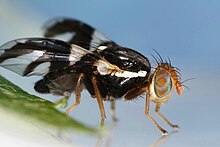Apple Maggot Quarantine Area
The Apple Maggot Quarantine Area is an area of the world which has been placed under a permanent quarantine by the United States state of Washington. The quarantine was established under state law and its exact boundaries are set, and periodically reset, by the state's Department of Agriculture. The quarantine was declared in the early 1980s to arrest the spread of the apple maggot into a portion of eastern Washington.
Establishment and purpose

The apple maggot, which is not indigenous to the Pacific Northwest, was discovered to have arrived in Washington in 1980.[1] The quarantine was declared thereafter and is designed to protect Washington's core apple growing regions from infestation.[1][2] According to the state's Department of Agriculture, the apple maggot "threatens Washington's iconic apple industry, as well as many of our other fruit crops".[3] Washington exported $718 million worth of apples in 2016, making apples the state's seventh largest export and the apple has been declared the official state fruit.[4][5] According to the Washington Apple Commission, the quality standards for Washington apples "are more stringent than grading standards used in any other growing region in the world".[6]
Authority for the quarantine is codified under Title 17 of the Revised Code of Washington.[7]
Quarantine regulations

Extent of the quarantine
As of 2017, the quarantine area consisted of the entire eastern United States, plus the states of Oregon, California, Idaho, and Utah.[8] All "foreign countries where apple maggot is established" have also been placed under quarantine by Washington.[8] All or portions of the state's own counties of Chelan, Clallam, Clark, Cowlitz, Grays Harbor, Island, Jefferson, King, Kitsap, Klickitat, Lewis, Lincoln, Mason, Pacific, Pierce, Snohomish, Spokane, Skagit, Skamania, Thurston, Wahkiakum, Whatcom, and Yakima, are also quarantined.[8] Areas of the state not included in the quarantine are referred to as the "pest free area".[8]
Terms of the quarantine
It is prohibited to transport homegrown or forraged fruit from the quarantine zone into the pest free zone, except for fruit that has first been processed through canning, jarring, juicing, or drying.[2][9] In addition, any yard waste from the quarantine zone must be disposed of within the zone and cannot be transported across its boundaries.[9][2][10] Commercially-packaged fruit is exempt from the quarantine as it is already subject to inspection by state authorities.[11]
In popular culture
Apple Maggot Quarantine Area, also known was A.M.Q.A., was the name of a metal band from Seattle active from 1985 to 1989.[12]
References
- ^ a b Sheets, Bill (June 8, 2012). "Apple maggot quarantine explained". Everett Herald. Retrieved December 4, 2017.
- ^ a b c "Apple Maggot Quarantine". WSDA. Washington Department of Agriculture. Retrieved December 4, 2017.
- ^ "Apple Maggot". agr.wa.gov. Washington Department of Agriculture. Retrieved December 4, 2017.
- ^ "Total U.S. Exports (Origin of Movement) from Washington". census.gov. U.S. Census Bureau. Retrieved December 4, 2017.
- ^ "del.wa.gov". Washington fun facts. Washington Department of Early Learning. Retrieved December 4, 2017.
- ^ "No Other Apple Comes Close". bestapples.com. Washington Apple Commission. Retrieved December 4, 2017.
- ^ "Power to adopt quarantine measures—Rules". Revised Code of Washington. State of Washington. Retrieved December 4, 2017.
- ^ a b c d "Area under order for apple maggot—Pest free area—Quarantine areas". Washington Administrative Code. State of Washington. Retrieved December 4, 2017.
- ^ a b "Washington state expands apple maggot quarantine area". Good Fruit Grower. January 10, 2017. Retrieved December 4, 2017.
- ^ Deshais, Nicholas (March 2, 2015). "New state rule on apple maggot puts Spokane yard waste recycling at risk". Spokesman Review. Retrieved December 4, 2017.
- ^ Klaus, Michael. "Apple maggot". Orchard Pest Management Online. Washington State University. Retrieved December 4, 2017.
- ^ "A.M.Q.A." The Metal Archives. Encyclopedia Metallum. Retrieved December 4, 2017.
